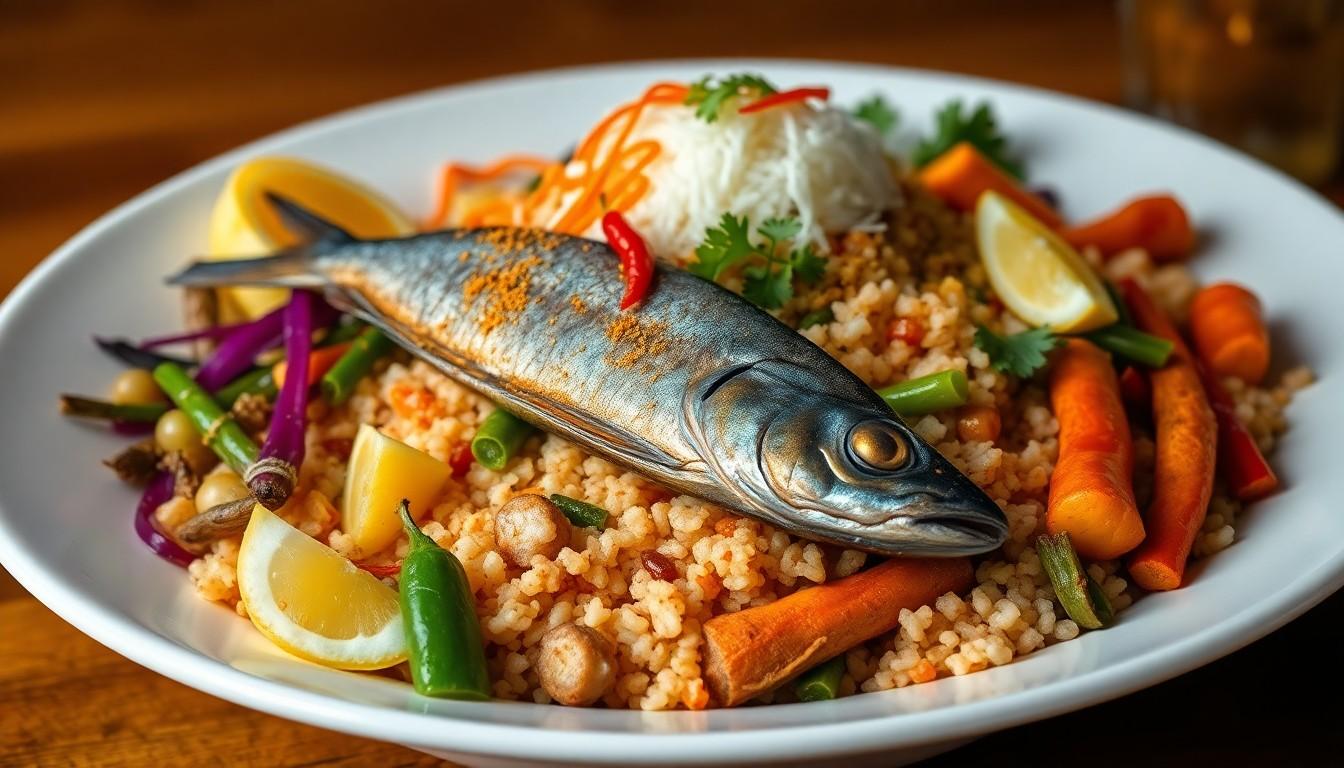In the heart of Myanmar, a culinary gem awaits those adventurous enough to seek it out: hingagyi. This delightful dish is more than just a meal; it’s an experience that dances on the palate and leaves a lasting impression. Imagine a fusion of flavors so vibrant that even your taste buds will throw a party—complete with confetti and a dance-off!
Overview of Hingagyi
Hingagyi represents a rich cultural dish steeped in Myanmar’s culinary tradition. Characterized by its distinctive blend of spices and textures, this dish captivates the palate with its vibrant flavors. Commonly enjoyed during festive occasions, hingagyi combines essential ingredients like rice, fish, and vegetables.
Traditionally, cooks prepare hingagyi with fresh, locally sourced components. The dish showcases an array of tastes, balancing savory and subtle nuances. Culinary enthusiasts appreciate its unique preparation methods, often incorporating fermentation techniques that enhance its depth.
Hingagyi typically features ingredients such as fermented tea leaves, which contribute to its signature taste. Often, the final presentation is colorful and visually appealing, inviting diners to indulge. Street vendors and home cooks alike pride themselves on crafting this beloved dish, passing down recipes through generations.
Nutritionally, hingagyi provides essential vitamins and minerals, making it a wholesome option. Many families enjoy this dish as a staple, celebrating its comforting essence. Curious eaters frequently explore variations, as regions within Myanmar offer distinct takes on the traditional recipe.
Sharing hingagyi represents more than just enjoying a meal; it fosters community connection and cultural appreciation. Festivities often revolve around this dish, showcasing its importance in gatherings. Overall, hingagyi stands as a testament to Myanmar’s rich culinary heritage.
Ingredients Used in Hingagyi

Hingagyi features a variety of fresh and flavorful ingredients that contribute to its unique taste.
Main Ingredients
Rice serves as the primary base for hingagyi, providing a hearty foundation. Fresh fish, often sourced from local waters, adds protein and enhances the dish’s savory profile. Vegetables, including pickled greens and root vegetables, bring vibrancy and texture. Fermented tea leaves stand out as iconic components, imparting a distinctive tang. Cooking methods may vary, but the focus remains on using local and seasonal ingredients, ensuring freshness in every bite. Each ingredient plays a crucial role in creating the harmonious blend that defines hingagyi.
Typical Spices
Essential spices drive the flavor dynamics in hingagyi. Turmeric lends warmth and a golden hue, while garlic provides an aromatic kick. Chili adds heat, appealing to those who enjoy spicier dishes. Salt balances flavors, enhancing each ingredient’s profile. Coriander and cumin contribute earthiness and depth, creating complexity in the dish. The careful selection and combination of spices elevate hingagyi from a simple meal to a culinary celebration, showcasing Myanmar’s vibrant culinary traditions.
Preparation Methods
Hingagyi brings together diverse cooking methods, reflecting Myanmar’s rich culinary practices. Both traditional and modern techniques contribute to the dish’s unique appeal.
Traditional Cooking Techniques
Traditionally, kitchens in Myanmar use clay pots over open flames for cooking hingagyi. Cooking rice demands careful attention to moisture levels, ensuring it remains fluffy. Fish often gets grilled or steamed, depending on local preferences. Adding vegetables typically involves sautéing them with spices to enhance flavor. Combining these ingredients results in a harmonious blend that maintains the authenticity of the dish. Local cooks embrace fresh, seasonal produce to preserve the dish’s flavor and nutritional value.
Modern Variations
Modern variations of hingagyi introduce innovative elements while maintaining core flavors. Some chefs experiment with grilling fish using advanced techniques, like sous-vide, to intensify tenderness. Incorporating ingredients like quinoa instead of rice caters to health-conscious consumers. Fusion approaches might combine hingagyi components with international cuisine, offering unique flavor profiles. Additionally, presentation often changes, focusing on plated servings that appeal visually. Modern technology also enables adjustments in cooking times, enhancing convenience without compromising taste.
Cultural Significance
Hingagyi holds a vital place in Myanmar’s cultural landscape. Traditionally served during significant festivals, this dish symbolizes unity, connection, and celebration among families and friends.
Festivals and Celebrations
During festivals, hingagyi often takes center stage at communal feasts. Such occasions include Thingyan, the Myanmar New Year, where families gather to share meals and celebrate the arrival of spring. Its unique flavors create a festive atmosphere, enhancing the joy of togetherness. At weddings, hingagyi showcases the culinary heritage, bringing vibrancy and warmth to the celebration. Community events also revolve around this dish, reinforcing cultural bonds and traditions.
Regional Variations
Regional variations of hingagyi demonstrate the diverse culinary influences across Myanmar. In coastal areas, seafood predominates, infusing dishes with local fish varieties, while mountain regions may showcase root vegetables and herbs. Different spices are utilized based on availability, creating distinct flavor profiles. Variations may include the use of fermented products unique to specific regions, showing adaptation to local tastes. Each version tells a story of place and tradition, reflecting Myanmar’s rich culinary diversity.
Health Benefits
Hingagyi offers numerous health benefits, making it a nutritious choice for many. High in protein, fresh fish serves as a primary ingredient, helping muscles and overall body function. Rice, as the base, provides carbohydrates for energy, fueling daily activities.
Vegetables play a significant role in enhancing nutritional value. Leafy greens and root vegetables contribute vitamins A and C, promoting healthy skin and boosting the immune system. Fermented tea leaves introduce probiotics, improving gut health and digestion.
Spices also contribute health benefits. Turmeric contains curcumin, known for its anti-inflammatory properties, which may help reduce chronic inflammation. Garlic supports cardiovascular health, aiding circulation and maintaining healthy blood pressure levels. Consuming chili can boost metabolism, assisting those looking to manage weight.
Minerals found in hingagyi add to its wholesome aspect. Zinc from fish supports immune function, while iron from various ingredients helps combat fatigue. The well-rounded combination of nutrients ensures that hingagyi is not just a flavorful dish, but also a wholesome option for families.
Hingagyi’s impact extends beyond individual health. Sharing this dish during gatherings fosters community bonds and cultural appreciation. Engaging in communal meals reinforces social connections, enhancing mental well-being among participants. Celebrating togetherness adds another layer of significance to the dish.
Overall, hingagyi encompasses delicious flavors and offers vital nutrients that contribute to the well-being of those who enjoy it. This traditional dish embodies the essence of Myanmar’s culinary artistry while nourishing both the body and the spirit.
Conclusion
Hingagyi is more than just a dish; it’s a celebration of Myanmar’s rich culinary heritage. Its vibrant flavors and diverse ingredients reflect the country’s cultural tapestry and foster community connections. As families gather to enjoy this delightful meal during festive occasions, they not only savor its deliciousness but also strengthen social bonds.
The evolution of hingagyi, with modern twists and variations, showcases its adaptability while honoring traditional roots. Whether enjoyed in its classic form or with contemporary innovations, hingagyi remains a beloved staple that embodies the spirit of togetherness and joy in Myanmar. Embracing this dish is an invitation to experience the heart of Myanmar’s culinary traditions.

